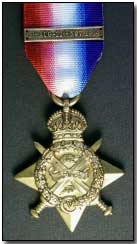Encyclopedia - 1914 Star
 The 1914 Star campaign
medal - also commonly referred to as the Mons Star - was awarded by British
authorities to those who served with either the British or Indian
Expeditionary Force in France or Belgium between the outbreak of war in
August 1914 and 22/23 November 1914.
The 1914 Star campaign
medal - also commonly referred to as the Mons Star - was awarded by British
authorities to those who served with either the British or Indian
Expeditionary Force in France or Belgium between the outbreak of war in
August 1914 and 22/23 November 1914.
This included medical personnel in addition to servicemen. Also eligible for the medal were naval and marine units stationed ashore (but none who were actually afloat throughout).
The medal was introduced in 1917. It gained renown - incorrectly - as the 'Mons Star', although the medal recognised additional actions fought in Belgium and France during the stated four months.
Comprising a lacquered bronze star, the uppermost star took the form of the imperial crown. A pair of crossed swords (topped by an oak leaf) featured on the obverse of the medal. An inscription upon the star bore the legend Aug-Nov 1914. The reverse of the medal carried the recipient's number, rank, name and unit.
A Bar was instituted by King George V on 19 October 1919 in recognition of men who "actually served under fire of the enemy" between the specified dates. The Bar bore the inscription 5 Aug to 22 Nov 1914.
Holders of the 1914 Star were not entitled to the subsequent 1914-15 Star.
Most recipients of the 1914 Star - 378,000 were issued in total - comprised the so-called 'Old Contemptibles', i.e. members of the pre-war British Army; many of these did indeed participate in the famed Mons retreat.
A "Bangalore Torpedo" was an explosive tube used to clear a path through a wire entanglement.
- Did you know?
